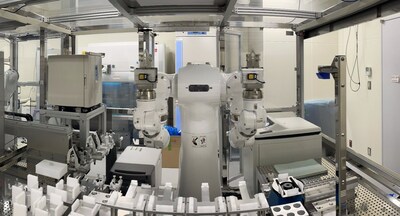CiRA, Kyoto University and Astellas Second Phase Joint Research Agreement Signed for Medical Applications of iPS Cells
On April 11, 2023, Kyoto University's Center for iPS Cell Research and Application (CiRA) and Astellas Pharma entered the second phase of their joint research agreement. This phase focuses on enhancing the use of differentiated cells from human induced pluripotent stem cells (iPS cells) for innovative medical solutions. Building on prior research from July 2017 to March 2023, the collaboration will establish a technological platform to produce high-quality iPS cell-derived cells. The key initiatives include developing evaluation systems to improve clinical predictability and creating new cell therapy programs. CiRA's Director, Jun Takahashi, and Astellas' CSO, Yoshitsugu Shitaka, express optimism about the potential advancements in drug discovery and treatment options for various diseases.
- Initiation of second phase research agreement to enhance drug discovery using iPS cells.
- Development of a technological platform for stable production of iPS cell-derived differentiated cells.
- Creation of advanced evaluation systems and new cell therapy programs aimed at addressing unmet medical needs.
- None.
During the first phase (
- Establishment of a technological platform for stable and high-quality production of iPS cell-derived differentiated cells and tissues by utilizing Mahol-A-Ba
Maintaining iPS cells in an appropriate state and programming them to differentiate into target cells require the technical expertise and astute judgment of experienced researchers. In addition, to evaluate the pharmacological effects of a compound, expert researchers must confirm whether iPS cells have differentiated correctly into target cells to completion. Therefore, the two parties will establish a technological platform for the stable and high-quality production of differentiated cells and tissues derived from iPS cells.
For the purpose of this joint research, CiRA installed Astellas' cellular drug discovery platform "Mahol-A-Ba"*2. The two parties will work together to construct digital protocols for Mahol-A-Ba to develop a high-quality and highly reproducible differentiation induction method and create a library of differentiated cells.
Mahol-A-Ba installed at CiRA (Please click here to watch the video)
2. Construction of a new evaluation system using iPS cell-derived differentiated cells and tissues
Cell types of various tissues and organs differentiated from iPS cells have been utilized to investigate the causes of diseases and to evaluate the pharmacological properties of drug candidates. By constructing advanced pathological models and models that can evaluate individual patient differences, the two parties aim to improve clinical predictability further and create medical solutions to treat diseases for which conventional methods have failed to provide viable options.
3. Creation of cell therapy programs using iPS cell-derived differentiated cells
The two parties will apply 1. and 2. above to create new cell therapy programs and resolve issues faced by current cell therapy in general (e.g., the establishment of efficient differentiation methods to target cells).
"The joint research agreement with Astellas, which includes state-of-the-art core technology for drug discovery, will be of critical importance to generating new possibilities of drug discovery using iPS cell technology. I would like to express my sincere gratitude to Astellas," said CiRA Director
"We are pleased to enter into this joint research agreement," said Yoshitsugu Shitaka, Ph.D., Chief Scientific Officer at Astellas. "We hope that the collaboration between CiRA, who has expertise in iPS cells and cell therapy, and Astellas, who has proven capabilities in drug discovery, will deliver even greater VALUE to patients."
CiRA and Astellas will further promote the use of iPS cell-derived differentiated cells and tissues to create innovative medical solutions to offer new treatment options for patients, thereby contributing to the treatment of diseases with high unmet medical needs.
*1: For more information on iPS cells, please visit CiRA's website: https://www.cira.kyoto-u.ac.jp/e/faq/faq_ips.html
*2: For more information on Astellas' cellular drug discovery platform "Mahol-A-Ba," please visit Astellas' website: (https://www.astellas.com/en/stories/strategy/dx_strategy_series_vol.2)
About Astellas
Cautionary Notes
In this press release, statements made with respect to current plans, estimates, strategies and beliefs and other statements that are not historical facts are forward-looking statements about the future performance of Astellas. These statements are based on management's current assumptions and beliefs in light of the information currently available to it and involve known and unknown risks and uncertainties. A number of factors could cause actual results to differ materially from those discussed in the forward-looking statements. Such factors include, but are not limited to: (i) changes in general economic conditions and in laws and regulations, relating to pharmaceutical markets, (ii) currency exchange rate fluctuations, (iii) delays in new product launches, (iv) the inability of Astellas to market existing and new products effectively, (v) the inability of Astellas to continue to effectively research and develop products accepted by customers in highly competitive markets, and (vi) infringements of Astellas' intellectual property rights by third parties.
Information about pharmaceutical products (including products currently in development) which is included in this press release is not intended to constitute an advertisement or medical advice.
![]() View original content to download multimedia:https://www.prnewswire.com/news-releases/cira-kyoto-university-and-astellas-second-phase-joint-research-agreement-signed-for-medical-applications-of-ips-cells-301794997.html
View original content to download multimedia:https://www.prnewswire.com/news-releases/cira-kyoto-university-and-astellas-second-phase-joint-research-agreement-signed-for-medical-applications-of-ips-cells-301794997.html
SOURCE
FAQ
What is the focus of the second phase research agreement between CiRA and Astellas?
What were the key objectives outlined in the joint research agreement signed on April 11, 2023?
Who are the key stakeholders involved in the joint research agreement?
What technology is being integrated into the iPS research by CiRA and Astellas?









